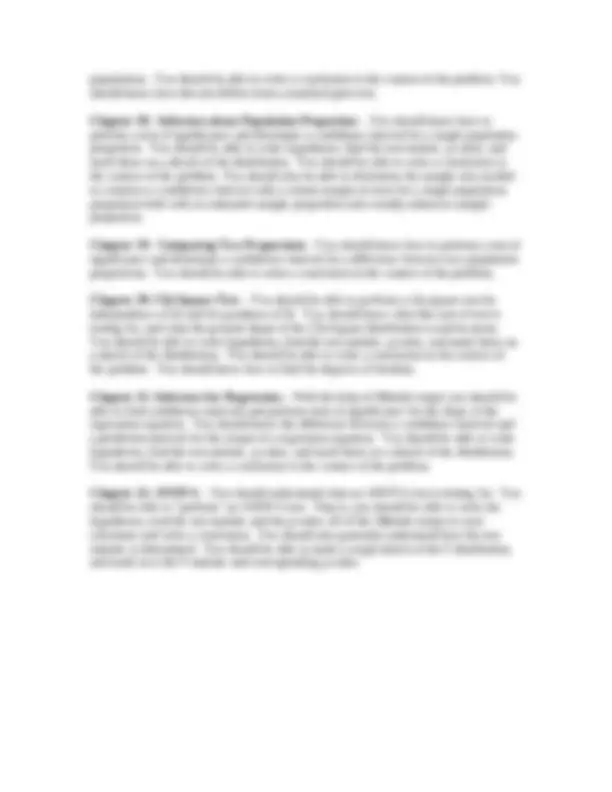



Study with the several resources on Docsity

Earn points by helping other students or get them with a premium plan


Prepare for your exams
Study with the several resources on Docsity

Earn points to download
Earn points by helping other students or get them with a premium plan
Community
Ask the community for help and clear up your study doubts
Discover the best universities in your country according to Docsity users
Free resources
Download our free guides on studying techniques, anxiety management strategies, and thesis advice from Docsity tutors
A review of the chapters covered in math 210 up to chapter 21 for the final exam. It includes an exam schedule, a list of topics to be studied for each chapter, and instructions to bring a calculator and formula sheets. The topics covered include constructing and interpreting various types of graphs, determining measures of central tendency and dispersion, understanding the normal distribution, and analyzing scatterplots and regression.
Typology: Exams
1 / 3

This page cannot be seen from the preview
Don't miss anything!


Math 210 Review for Final Exam Final Exam Schedule: 12:00 class: Fri, May 6 at 8:00, VZN B 1:00 class: Wed, May 4 at 2:00, VWF 104 2:00 class: Thur, May 5 at 10:30, VZN B *** Don’t forget to bring a calculator and your formula sheet(s). No sharing allowed. The Final exam is cumulative. Chapter 1: Picturing Distribution with Graphs – You should be able to construct and interpret histograms, bar graphs, stemplots, pie charts, and time plots. You should be able to determine if a distribution is symmetric or skewed, or if it has any outliers. You should also know the difference between categorical and quantitative variables. Chapter 2: Describing Distributions with Numbers – Given a data set, you should be able to determine its mean, median, standard deviation, quartiles, and five number summary. You should know when a mean is appropriate to use and when a median is appropriate, and how the shape of a distribution affects the mean and median. You should know what the interquartile range is and be able to construct boxplots. Chapter 3: The Normal Distribution – You should know how to find the standardized score (z) of a number from a Normal distribution. You should be able to find the probability above, below or between given z-score(s) (using Normcdf). You should also be able to give the value (x) given the probability (using invNorm). You should know what the 68-95-99.7 rule is and how it is used. You should know how and differ from x and s. Chapter 4: Scatterplots and Correlation – You should know the difference between explanatory and response variables. You should be able to construct a scatterplot and describe its direction, form, and strength. You should know what correlation measures. Chapter 5: Regression – You should be able to plot a regression line, use a regression equation to predict an outcome for a given input, and know what the y -intercept and slope mean in the context of the problem. You should know what r^2 means. You should know how to calculate residuals and make a residual plot. You should know what the following terms mean and how they affect correlation and regressions: lurking variables, influential observations, and extrapolation. You should know the relationship between correlation and causation. Chapter 6: Two-Way Tables – You should be able to read a two-way table and understand the difference between marginal and conditional distributions. You should be able to calculate conditional probabilities.
Chapter 7: Sampling – You should know what conditions lead to bias results when sampling a population. You should know what the following mean: probability sampling, SRS, stratified random sample. Chapter 8: Experiments – You should know what the following terms mean: treatments, subjects, factors, control, double-blind, matched-pairs. Chapter 9: Introducing Probability – You should be able to describe what the probability of some event means. You should also know the difference between a parameter and a statistic. You should know what the following terms are: sample space, event, complement, disjoint, random variable, probability distribution. Chapter 10: Sampling Distribution – You should know what the Central Limit Theorem is and how it is used. You should know what a sampling distribution is and how its shape is different from the distribution of single observations. You should be able to find probabilities, using the normal distribution, associated with a sampling distribution. Chapter 11: General Probability Rules – You should know and be able to use the four basic rules for probability given on p. 281. You should be able to use the multiplication rule for independent events. You should be able to find conditional probabilities. You should be able to fill in Venn Diagrams and Tree Diagrams for two events. Chapter 12: Binomial Distributions – You should know what a binomial distribution is, when it can be used, and be able to determine probabilities associated with a binomial distribution using the formula or your calculator. You should be able to determine the mean and the standard deviation of a binomial count. Chapters 13 and 14 are covered in the following chapters. Chapter 15: Inference in Practice – You should know certain things to be aware of when conducting a test of significance. You should know the difference between statistically significant and practical significance. You should know what Type I erros are. Chapter 16: Inference about a Population Mean – You should know how to perform a test of significance and determine a confidence interval for the mean of a population or a matched pairs comparison. You should be able to write hypotheses, find the test statistic, p-value, and mark these on a sketch of the distribution. You should be able to write a conclusion in the context of the problem. You should know the assumptions and limitations of using t -procedures. You should know how to calculate the standard error of the mean. Chapter 17: Two Sample Problems – You should know how to perform a test of significance and determine a confidence interval for the difference in the means of two